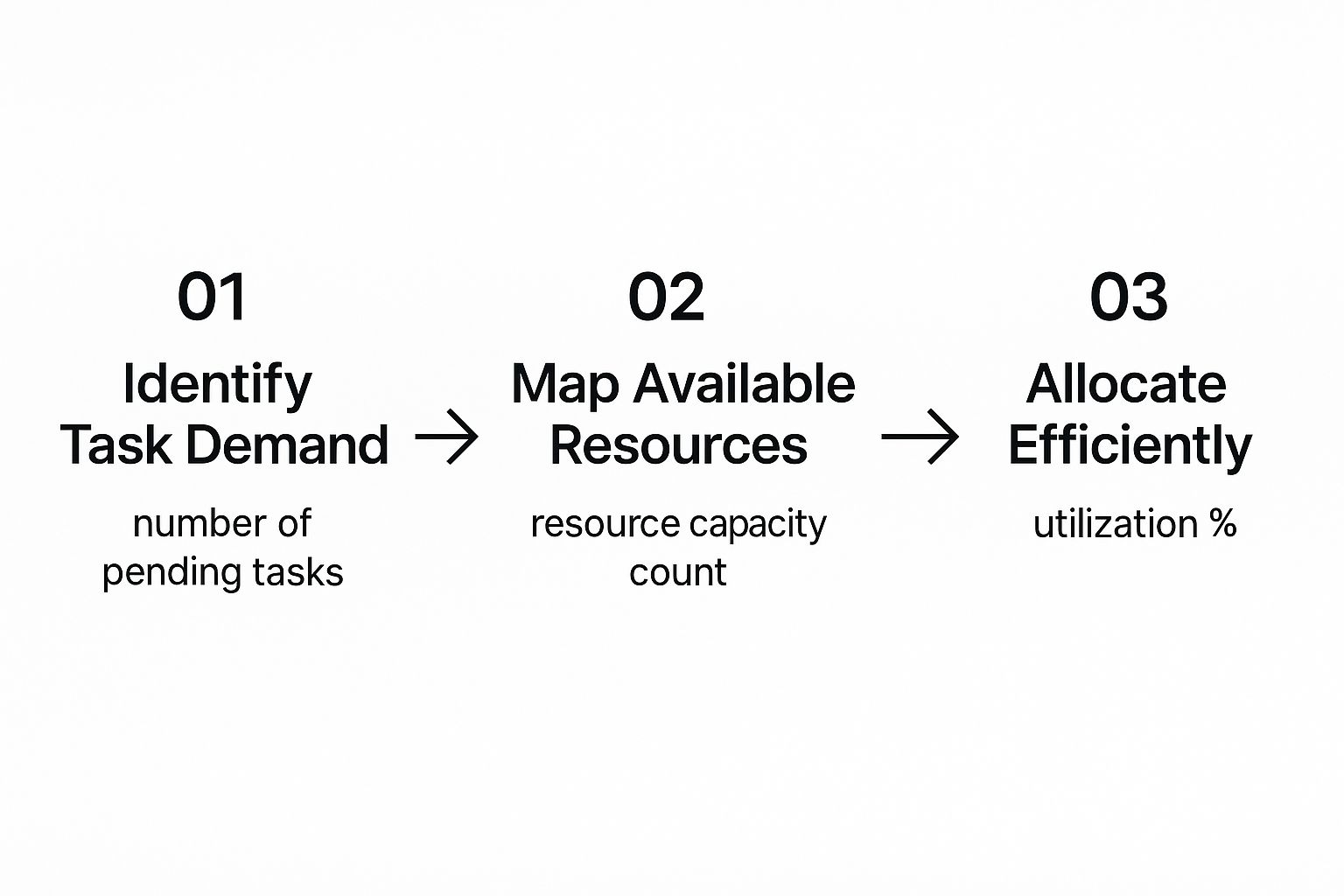Let's get real for a second—"optimizing resource allocation" sounds like something you'd hear in a stuffy boardroom, not something that applies to a growing business or agency. But in practice, it’s the one thing that separates smooth sailing from constant chaos.
It’s less about fancy Gantt charts and more about answering the tough questions that pop up every day.
Are the right people on the right projects? Is my best designer burning out on low-impact tasks? Is our budget getting eaten alive by tiny, inefficient habits? Getting this right is everything.
Why Resource Allocation Is a Game-Changer for Your Business

When resource allocation goes wrong, the signs are impossible to ignore. Team members get stretched thin, morale tanks, and turnover starts to climb. Suddenly, project timelines are slipping, deadlines are getting missed, and all that momentum you worked so hard to build just… stops.
Worse yet, you start seeing money disappear. Small, unmonitored costs and clunky workflows slowly chip away at your profits, making it nearly impossible to invest in real growth. This isn't just a management headache; it's a direct threat to your bottom line. We've got a whole guide on reducing production costs if you feel that pain.
The goal isn't to squeeze every last drop of productivity out of your team. It's about creating a sustainable, balanced system where people have the space to do their best work without hitting a wall.
The Power of Planning Ahead
Shifting from reactive to proactive changes the entire game. Instead of constantly putting out fires, you’re looking ahead, anticipating needs, and making deliberate choices. That kind of foresight is a massive competitive advantage.
And it’s not just a gut feeling; the data backs it up. One 2025 resource management study found that 64% of organizations see improving resource allocation as a top priority. But here’s the kicker: only 16% actually planned to invest in software to fix it. That's a huge gap between knowing there's a problem and doing something about it. You can dig into more of that study's findings over on Runn.io.
When you finally nail resource allocation, it all clicks into place. You start delivering high-quality work, consistently, on time and on budget. That’s how you build a rock-solid reputation and a business that’s built to last.
To help visualize this, let's break down the three core resources every small business juggles and the common traps that come with mismanaging them.
Core Resources and Their Impact on Growth
| Resource Type | Primary Optimization Goal | Common Pitfall to Avoid |
|---|---|---|
| People | Align skills with high-impact tasks. | Overloading top performers, leading to burnout. |
| Time | Protect focus and minimize context switching. | Unrealistic deadlines that kill momentum and quality. |
| Budget | Direct funds toward profitable activities. | Letting small, unmonitored costs drain profits. |
Each of these resources is a lever for growth. When they're all working in sync, you create momentum. When one is out of alignment, it can bring everything to a grinding halt. The key is to be intentional about where each one is going.
Getting an Honest Look at Your Resources
You can’t fix a problem you can’t see. Before you start rearranging workflows or trying new strategies, you have to get an unfiltered look at where your resources—people, time, and budget—are actually going. This isn’t about getting lost in massive spreadsheets. It’s about building a simple, honest 'resource map'.
Think of this map as your starting point. It’s what gives you the clarity to shift from constantly putting out fires to actually planning ahead. It will show you the hidden patterns, like which projects are secret time-sucks or which team members have skills you aren't even using. Without this baseline, you’re just guessing.
Creating Your Resource Inventory
First, take stock of your people. Go beyond their job titles. What are they really good at? What do they love doing? Your junior designer might be a whiz at copyediting, or maybe your PM has a secret talent for data analysis. A simple skills inventory can uncover these hidden gems, giving you way more flexibility when projects come up.
Next up is time. Where does it really go? Time-tracking data is gold here, but the magic happens when you compare the hours you planned against the hours that were actually spent. This is how you find bottlenecks and see which tasks you’re consistently underestimating. For a deeper dive on managing your team’s capacity, our guide to creative resource management has some great frameworks.
Finally, follow the money. Pick a few recent projects and audit the budget. See exactly where the cash went and stack it up against your initial estimates. You’ll be surprised at how often this exercise uncovers those small, sneaky costs that add up over time or reveals which phases of a project are sucking the budget dry.
Tracking and Measuring What Matters
Once you have that initial snapshot, you can't just stop there. Ongoing monitoring is what separates the good teams from the great ones. You have to keep your finger on the pulse to spot bad trends before they snowball into major problems.
A common mistake is treating resource management as a one-time setup. True optimization comes from continuous monitoring and adjustment. It’s an ongoing process of learning and refining how your team works best.
For example, keeping a regular eye on resource utilization helps prevent burnout and keeps workloads from getting out of whack. In fact, research from the Resource Management Institute shows that tracking this weekly or monthly is crucial for catching issues early. According to Runn.io, this kind of rigorous monitoring is the backbone of preventing bottlenecks from derailing your projects. Find out more about these resource management insights on Runn.io.
By creating this clear, visual map of your resources, you’re giving yourself the power to make smart decisions. You’ll know exactly who is free, what they’re capable of, and how much gas is really left in the tank. With that foundation in place, every other step you take to optimize your resources will be that much more effective.
Choosing the Right Allocation Strategy
Once you’ve got a clear picture of what—and who—you have to work with, it’s time to move from auditing to action. Choosing the right allocation strategy isn’t about installing some complex, rigid system nobody will follow. It’s about finding a simple framework that helps you make consistent, logical calls about where your team’s precious energy should go.
The real goal here is to connect every single task to a larger business objective. This is how you make sure you’re not just busy, but actually productive. By putting on a strategic lens, you can start filtering out all that low-impact work that just drains time and focus on what genuinely drives results.
Frameworks for Smarter Prioritization
One of the most powerful tools for this is the good old Eisenhower Matrix. It’s a simple grid that helps you sort tasks by how urgent and important they are. This forces you to get real about the difference between tasks that feel urgent (like a panicked client email about a minor tweak) and those that are truly important (like nailing a key project milestone).
Using this framework helps your team see the difference between the "loudest" tasks and the most valuable ones.
- Important and Urgent: These are your fires and your must-dos. Throw your resources here first to handle crises or hit those non-negotiable deadlines.
- Important but Not Urgent: This is where real, strategic growth happens. You have to actively protect time and resources for these goals, like improving a clunky process or developing a new service offering.
- Urgent but Not Important: Think of these as the interruptions that can completely derail a productive day. The key is to delegate them or create super-efficient processes to knock them out fast.
- Not Urgent and Not Important: These tasks need to go. They’re time-wasters that add almost zero value to your bottom line.
A classic trap is letting that "Urgent but Not Important" box run your team's entire week. A smart strategy protects your most valuable assets—your team's focus and creativity—for the work that actually moves the needle.
This simple process flow shows how you can connect the demands coming in with the resources you actually have.

As you can see, optimizing how you allocate resources really starts with a clear-eyed look at task volume before you can effectively map your capacity and put your team to work.
Balancing Workloads with Capacity Planning
Prioritizing tasks is one thing, but you also have to be realistic about what your team can handle. That's where capacity planning comes in. It’s the process of making sure you have enough people-power to meet demand without burning everyone out. We get into the nitty-gritty of this in our guide on creating a staffing plan example, which has some practical templates to get you started.
Industry benchmarks really drive this point home. The tech sector, for instance, often runs at a 68% to 78% resource efficiency rate. Meanwhile, manufacturing can hit as high as 82%. What these numbers show is that the best-performing organizations are constantly fine-tuning their planning to get the most out of their teams without pushing them over the edge.
If you really want to go deep on specific methods, especially in project-based environments, it's worth checking out resources on mastering project management resource allocation. These kinds of techniques help you make sure your big strategic priorities are backed up by a plan that’s actually achievable, setting your projects—and your people—up for success from day one.
Using Tech to Make Smarter Decisions
Let's be real: relying on gut feelings and a labyrinth of spreadsheets to manage your team's workload just doesn't cut it once you start to grow. Those manual tracking methods and endless email chains quickly become bottlenecks. You're left guessing who’s working on what, and whether you're even close to hitting your deadlines.
This is the point where technology stops being a "nice to have" and becomes your essential co-pilot for smarter decision-making.
Modern project management and resource scheduling tools give you a single source of truth. They pull your operations out of scattered documents and into a central hub where everyone—and I mean everyone—can see real-time updates on workloads, timelines, and budgets. This kind of clarity is the bedrock of effective resource allocation.

This software gives you a bird's-eye view of project phases and dependencies, which makes spotting potential resource conflicts before they derail your project so much easier. It's about moving beyond simple to-do lists and getting into truly strategic capacity planning.
Finding the Right Tool for Your Team
The market is absolutely flooded with options, and picking the right one can feel like a job in itself. My advice? Don't get distracted by flashy features you’ll never actually use.
Instead, zero in on the core functions that solve your biggest resource headaches right now. For a deep dive into what works best for creative teams, check out our guide on https://creativize.net/blog/project-management-tools-for-creative-agencies.
A good starting point is to look for tools that offer:
- Capacity Forecasting: The power to see your team's availability weeks or even months down the road.
- Utilization Reports: Clean, simple dashboards that show you who's overbooked and who has room to take on more.
- Centralized Task Management: A shared space where tasks can be assigned, tracked, and updated without a million emails.
The best tool isn't the one with the most bells and whistles; it's the one your team will actually adopt and use every day. Start with a simple solution that solves an immediate pain point. Don't be afraid to test a few options before you commit.
And it doesn't stop there. The integration of artificial intelligence is making these tools even smarter. AI-powered features can analyze your project data, predict future demand, and suggest real-time tweaks to your resource plan. This helps you balance your finite resources with your performance goals.
To help you navigate the options, here’s a quick breakdown of the different types of tools available.
Choosing the Right Resource Tool for Your SMB
| Tool Category | Primary Function | Best For | Example Tools |
|---|---|---|---|
| Project Management | Organizing tasks, timelines, and collaboration on a project-by-project basis. | Teams needing a central hub for daily work, communication, and file sharing. | Monday, Asana, Trello |
| Resource Scheduling | Planning and visualizing team capacity and availability across multiple projects. | Agencies and studios needing to prevent overbooking and forecast hiring needs. | Float, Resource Guru |
| All-in-One Platforms | Combining project management, resource scheduling, time tracking, and financials. | Businesses wanting to connect project execution directly to profitability and billing. | Kantata, Forecast |
| Time Tracking | Monitoring hours spent on specific tasks and projects for billing and analysis. | Freelancers and teams that bill by the hour or need to track project profitability. | Harvest, Toggl |
Each category solves a slightly different problem, so think about where your biggest bottleneck is and start there.
Bringing a new tool into your workflow needs a thoughtful approach. Kick things off with a single project or a small team to work out the kinks. Provide clear training and, most importantly, show them how the software makes their jobs easier—not just adds another layer of tracking.
For larger organizations, understanding the frameworks for complex challenges, like those involved in optimizing enterprise grant management, can offer a useful parallel. The goal is always the same: let technology handle the tedious work so you can focus on the big-picture, strategic moves that really matter.
How to Monitor and Adapt Your Strategy
Let's be real: resource allocation is never a "set it and forget it" kind of deal. Your initial plan? That's just a starting point—your best guess based on what you know. The real magic happens when you treat it like a living thing, something you constantly plan, execute, monitor, and tweak.
Without this feedback loop, even the most brilliant strategy can go sideways fast. Client needs shift, priorities change, and unexpected roadblocks pop up. Staying agile is the name of the game. It’s how you spot small issues before they become project-killers and make sure your team's energy is always focused on what actually matters right now.
Think of it like steering a ship. You can't just point it in the right direction and hope for the best; you have to make constant, small adjustments to stay on course.

Key Metrics to Watch Closely
So, how do you know if your plan is actually working? You need to track a few key metrics. These aren’t just numbers to fill a spreadsheet; they're the vital signs of your projects and your team. The trick is not to get lost in a sea of data. Just focus on a handful of indicators that give you the most bang for your buck.
A great place to start is with resource utilization rates. This metric tells you exactly how much of a team member's available time is being spent on billable or productive work. Honestly, it's your best early warning system for burnout. Some research from Runn.io even shows that when utilization goes over 125%, projects almost always get delayed. The sweet spot is usually around 80%, which gives your team some breathing room.
Beyond just utilization, you'll want to keep an eye on these two:
- Project Budget Variance: This one's simple: how does your actual spending stack up against your planned budget? It’s a quick and dirty way to see if a project is turning into a money pit.
- On-Time Completion Rate: Are you hitting your deadlines? If your projects are consistently late, it’s a massive red flag that your time or resource estimates are way off.
Tools can obviously make this a whole lot easier. If you need a simple way to keep tabs on things, we've put together a guide on creating a project progress tracker.
The goal isn’t to micromanage your team. It’s about getting enough visibility to make smart, proactive adjustments instead of constantly putting out fires.
Gathering Feedback and Making Adjustments
Data tells you what's happening, but it's your team who can tell you why. That's why regular, informal check-ins and more structured project retrospectives are absolute gold.
These conversations are where you find the real story behind the numbers. You’ll uncover the clunky processes, the communication gaps, and all the little friction points that data alone will never show you.
To get the good stuff, you need to create a space where people feel safe being honest. Ditch the yes/no questions and ask things that actually get a discussion going.
- "What was the most frustrating part of that last sprint?"
- "Where did you feel like you had everything you needed to crush it?"
- "If we could change one thing about how we plan projects, what should it be?"
This kind of feedback is invaluable. It helps you iterate on your resource plan, making it a little smarter and more realistic with every project you complete. This approach to optimizing resource allocation isn't a one-time fix; it's about building a culture where you're always getting better.
Still Have Questions About Resource Allocation?
Even with a solid game plan, you're bound to run into a few tricky situations when you start juggling resources. Let's walk through some of the questions I hear most often from small business owners and agency leads.
Our Team Is Small. Where Do We Even Begin?
When you’re a small, tight-knit team, your first move should be all about visibility. Forget complicated software for now.
Just create a central, shared space—a simple digital whiteboard or a spreadsheet will do the trick. List out every project and its main tasks. Then, pop an owner and a quick time estimate next to each one.
That one move pulls everyone's work out of the shadows and into the open. You can immediately see who’s drowning in tasks and where the next bottleneck is going to be. It gives you a real, tangible starting point for balancing the load.
The goal right now isn't perfect efficiency; it's shared awareness. When the whole team sees the full picture, they naturally start to pitch in and help each other out.
Think of it as the foundation for everything else you'll do to manage your team's time and energy.
How Often Should We Revisit Our Resource Plan?
Your resource plan isn't a "set it and forget it" document you dust off once a quarter. For most small businesses, a weekly check-in is the sweet spot.
This doesn't have to be a big, formal meeting. A quick 15-20 minute huddle to look at the week ahead is perfect.
This rhythm keeps you nimble and lets you:
- Adapt on the fly: A client has new feedback? A project scope changes? You can re-prioritize in minutes, not weeks.
- Spot burnout before it happens: Notice someone's plate is overflowing? You can reassign a few tasks before they get overwhelmed.
- Stay on track: These small, weekly adjustments ensure you’re always putting your energy into what matters most right now.
It's like making tiny course corrections to keep the ship sailing smoothly toward its destination.
What Happens When Unexpected Conflicts Pop Up?
Resource conflicts are just part of the game. Your top designer suddenly gets pulled onto two high-priority projects at once, or a key developer has to drop everything for an urgent bug fix. It happens.
When it does, the first step is to clarify the real priority. Don't just react—ask which task truly has a bigger impact on your business goals or a key client relationship today.
Once you've made the call, communicate it. Be upfront with everyone involved. Explain the conflict, the decision you made, and what the new timeline looks like for the task that has to wait. A little proactive communication can turn a potential crisis into a manageable schedule tweak, keeping trust intact with both your team and your clients.
Ready to put your well-planned projects into action with the right creative talent? Creativize makes it simple to find and hire local pros with the exact skills you're looking for. Find your next creative partner on Creativize.

